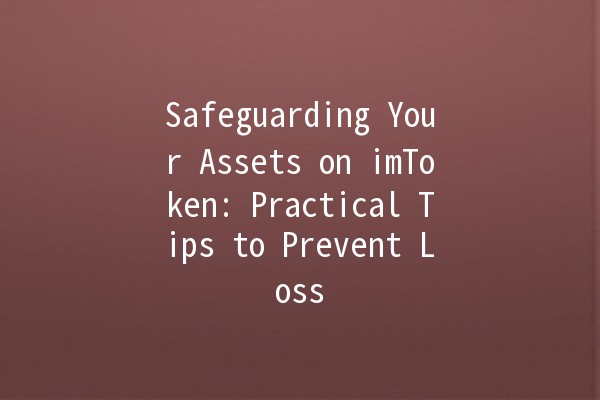In today's digital age, crypto wallets have become an essential tool for managing and storing cryptocurrencies. Among these, imToken has emerged as a popular choice, thanks to its userfriendly interface and robust security features. However, the risk of losing assets remains a significant concern for users. This article will highlight practical tips on how to safeguard your assets on imToken.
imToken is a digital wallet that allows users to manage multiple cryptocurrencies securely. It provides features like decentralized finance (DeFi) integration, token exchange capabilities, and secure custody for private keys. Before diving into preventative measures, it's crucial to understand how imToken's security works.
Private Keys: In imToken, users hold their private keys, meaning they have complete control over their assets. The wallet uses a mnemonic phrase to reinforce this security.
MultiLayer Security: This wallet employs various security layers, including biometric authentication and a strong password requirement.
Regular Updates: The development team frequently updates the app to patch potential security vulnerabilities.

While these features are in place, users must also exercise caution to prevent asset loss.
Your mnemonic phrase is the most critical piece of information for accessing your imToken wallet. Here are a few best practices for keeping it secure:
Writing It Down: Write your mnemonic phrase on paper and store it in a safe place, away from prying eyes.
Avoid Digital Storage: Never store your mnemonic phrase in cloud storage or email. If a hacker gains access to your accounts, they can easily steal your funds.
Create Backups: Keep multiple copies in different secure locations, ensuring you have access even if one is lost or damaged.
Example: Jane wrote her mnemonic phrase on a piece of paper and put it inside a safe in her house. When her phone broke, she was relieved to have backed it up securely.
Biometric authentication adds an extra layer of security by requiring a fingerprint or facial recognition to authorize transactions. To activate this feature:
Visit Security Settings: In your imToken settings, find the security section.
Turn on Biometric Authentication: Enable this feature to protect your wallet from unauthorized access.
Example: When John enabled biometric authentication, he felt secure knowing that even if someone stole his phone, they wouldn't be able to access his wallet without his fingerprint.
Keeping your wallet software updated is vital for security. Developers constantly work to patch vulnerabilities. To ensure your imToken is current:
Enable Automatic Updates: Check your app settings and enable automatic updates to download the latest security patches.
Regularly Manually Check: Periodically visit the app store to see if updates are available.
Example: Maria regularly checks for updates and, before a recent upgrade, learned about a critical vulnerability that was patched in the new version.
A strong password can significantly enhance your wallet's security. Here are guidelines for creating and maintaining strong passwords:
Mix Characters: Use a combination of upper and lowercase letters, numbers, and special characters.
Avoid Common Passwords: Do not use easily guessable passwords like "123456" or "password".
Utilize a Password Manager: Consider using a password manager to generate and store complex passwords securely.
Example: Tom used a password manager to create a long, complex password for his wallet, making it nearly impossible for anyone to guess.
Phishing is one of the most common methods employed by cybercriminals to steal information. Here’s how to protect yourself:
Verify URLs: Always doublecheck the URL before entering your credentials. Ensure you are on the official imToken website or app.
Do Not Trust Unsolicited Messages: Be cautious of messages or emails claiming to be from imToken asking for personal information.
Enable TwoFactor Authentication: If applicable, turn on twofactor authentication for an added security layer.
Example: Lisa received an email claiming to be from imToken with a link to “verify” her account. She doublechecked the email address and realized it was fake, ultimately saving her assets.
Forgetting your mnemonic phrase can lead to permanent asset loss. If you’ve written it down securely, retrieve it from your storage. If you cannot find it, unfortunately, there’s no way to recover your wallet or funds.
No, you cannot directly change your mnemonic phrase on imToken. The only way to change your phrase is to create a new wallet and transfer your assets there. Ensure you back up the new mnemonic phrase immediately.
If you suspect your wallet may be compromised, immediately transfer your assets to a new wallet with a fresh mnemonic phrase. Additionally, change your passwords and check for any unauthorized transactions.
Connecting your imToken wallet to dApps can be safe, but always conduct thorough research before granting any permissions. Ensure the dApp is legitimate, and consider using a separate wallet for dApp interactions.
Public WiFi networks are often not secure and can expose you to cyber threats. If possible, always use a Virtual Private Network (VPN) or a secure network when accessing your wallet.
Regular monitoring of your assets is essential to ensure no unauthorized transactions occur. Consider checking your wallet at least once a week and set alerts if your wallet offers this feature.
In summary, safeguarding your assets on imToken requires a combination of best practices. By securing your mnemonic phrase, enabling biometric authentication, keeping software updated, using strong passwords, and being aware of phishing attacks, you can significantly lower your risks. Following these tips not only preserves your investments but also enhances your overall cryptocurrency experience. Remember, security starts with you!